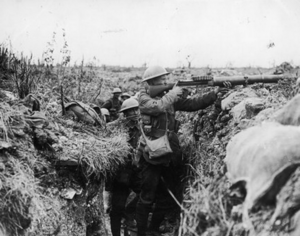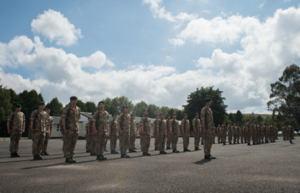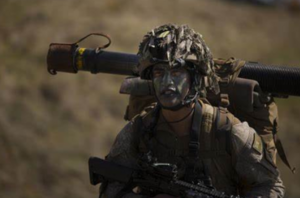Royal Arcerion Infantry Corps: Difference between revisions
m Text replacement - "Category:2023 Award winning pages" to "{{Template:Award winning article}} Category:2023 Award winning pages" |
|||
| Line 123: | Line 123: | ||
* Presdale Loyal Regiment | * Presdale Loyal Regiment | ||
[[Category:Arcerion]] | [[Category:Arcerion]] | ||
{{Template:Award winning article}} | |||
[[Category:2023 Award winning pages]] | [[Category:2023 Award winning pages]] | ||
[[Category:IXWB]] | [[Category:IXWB]] | ||
[[Category:Military units]] | [[Category:Military units]] | ||
Latest revision as of 10:16, 10 August 2023
| Royal Arcerion Infantry Corps | |
|---|---|
| RAIC, RIC | |
 Camp Flag of the Royal Arcerion Infantry Corps | |
| Founded | September 1st, 1812 |
| Country | |
| Branch | |
| Type | Infantry |
| Role | Land Warfare Close-quarters combat Urban Warfare Reconnaissance Mountain Warfare Airborne Operations |
| Size | 28+ Regiments |
| Garrison/HQ | Rosmore Barracks, Kinnaird Garrison |
| Nickname(s) | "Poor Bloody Infantry" |
| Patron | Honorary Colonel Timothy O'Shea |
| Motto(s) | In pede in valles "On foot over the glen" |
| Colors | Green, Red, White |
| March | Royal Arcerion Regiment at the Advance |
| Anniversaries | 1 September 1812 (founding) 17 June 1960 (Battle of Teremba) 23 July 1960 (Battle of M'kelo Airport) |
| Engagements | Arcer Bush Wars First Great War Ardmori Civil War Second Great War Istrenyan Crisis Final War of the Deluge |
| Commanders | |
| Colonel Commandant | Maj-Gen. Eachthighearn Ó hEimhín |
The Royal Arcerion Infantry Corps is the component branch of the Arcer Army that is responsible for the training, doctrinal development, and organization of infantry units within the Armed Forces. It includes all of Arcerion's infantry regiments regardless of status, be it Regular or Reserve, some of which that have historical lineages that are over two centuries old. The modern Infantry Corps has a large number of infantry regiments, individual battalions, as well as training sites and facilities that make it one of the largest non-formation organizations within the Arcer Army. It is the backbone of the Infantry's history, heritage, and tradition and is based in Kinnaird at the Rosmore Barracks, named for the Ardmori City for where the Corps fought significant actions during the Ardmori Civil War.
The Corps was bestowed with the title "Royal" upon its creation in 1812 as recognition by the King of Ardmore for its service during the First Bush War.
History
Colonial History
The infantry in Arcerion's earliest origins are those of militias and town watches, also known locally as 'Minutemen,' for their readiness to react quickly to a native incursion or threat to colonial domiciles. These loosely organized bands of citizen-soldiers fought during the First Bush War in support of Ardmori regular troops, as well as after their organization into militia companies under Crown-Governor John Hughes, who ratified them as the Arcerion Loyal Militia, whose modern colours, heritage, and battle honours are carried on by the Royal Moorden Regiment.
Throughout the colonial period (until the First Great War), Arcerion's infantry would be dual in purpose, both as part-time militia troops as well as new Arco citizens and naturalized Ardmori settlers into regular infantry battalions. This culminated with concurrent successful campaigns in the Second and Third Bush Wars, where well trained and disciplined Arcer infantry formations often fought Indigenous forces several times their number and were victorious.
The major trend over the period before the Corps' founding in 1812, and up to the First Great War, was a century of structuring and expansion. The introduction of new Regiments, establishment of Guards, Fusiliers, and Rifle battalions, the creation of professional military academies and schools, as well as the first non-commissioned officer training facility in Crona (Adjutant, Quartermaster, and Warrant Officer's Academy was established in 1833 in Kinnaird) helped propel the Corps towards what would be required of it in the 20th century as warfare modernized and developed.
Early 20th-century

The early 20th Century saw the Corps fight in two great wars in the first fifty years, as well as a significant action in Levantia as part of the campaign against rebel communist forces in Ardmore. The Corps also made significant advancements with the adaptation of established methods of instruction and employment, and worked to implement new technologies learned from partners or adversaries. Innovations such as machine guns, steel helmets, hand grenades, infantry mortars, platoon and company wireless radio sets, and modern marksman techniques all helped over the course of fifty years to mould the infantry into a modern fighting force. The First Great War saw the Regiments of the Infantry Corps engaged in the South against Paulastra, and was characterized by significant amounts of mountain and alpine warfare, as well as trench warfare and the first modern urban fighting conducted by the Arcer Army. With little previous 'siege' experience, the Army as a whole was unprepared, as it had traditionally been a more mobile, maneuver-focused force accustomed to fighting in the Arcer Heartland against Indigenous forces, however by the conclusion of the Washakaran Campaign, the Army, and especially the infantry, had made good use of working with sappers and engineers, and developed methods for the quick emplacement of guns, mortars, and trench systems to reflect the realities of their war. These lessons were not forgotten as many veterans of the First Great War went on to serve in the Ardmori Campaign to help fight communist insurrections in Levantia, and to defend the Crown Regent. Despite losing the campaign due to the collapse of the Royal Ardmori Army, the Regiments that fought there conducted successful actions on both islands as well as during their withdrawal, assisting with the evacuation of thousands of Ardmori citizens who would flee and seek refuge in Arcerion.
Actions during the Second Great War were mostly centered around Operation Lightfoot and the invasion of the Cape. The Corps had introduced prior to the war the first parachute infantry, modern paratroopers, and they were used heavily in the first phases of the campaign as they assisted with the surprise invasion of Capetian territory. The subsequent conventional fighting for the next few years was of a traditional nature to the Regiments of the Arcer Infantry, and the campaign was overall a success despite the Army not capturing Cape Town. The conflict also saw the establishment of the first Special Forces units within the Arcer Army, where experienced infantrymen, NCOs, and officers were selected to assemble into special commando units to conduct raids against Caphirian, Capetian, and enemy facilities, usually by night time infiltration via parachute or kayak, where they would help keep the anti-League forces weakened and unable to threaten Arcerion and its allies.

Occidental Cold War
During the Cold War Crona saw a significant amount of turmoil as syndicalism and communist forces began to turn to the continent as it was a god area to stage socialist insurrections and coups due to wealth disparity between Occidental colonial states and their Indigenous neighbours. This was evident with the Istrenyan Crisis, where Arco troops, primarily infantrymen, fought to ensure that the existing populist government, which was sympathetic to Arcerion and Occidental commerce, remained in control of the state. Threatening the Warrington Straits, a critical maritime navigational point that connects the Malentine and Songun Sea, the communist forces were eventually pushed back, as members of the Arcer Army (primarily light infantry regiments such as the Norham Light Infantry and Royal Easthampton Borderers) battled communist and socialist liberation forces through the lowland foothills, mountains, and valleys of Western and Southern Istrenya. The conflict was a resounding success, again demonstrating that well-equipped and enabled infantry trained in the Arcer method would continue to be the mainstay of the armed forces.
The Fourth Bush War continued to reaffirm this, as the counter insurgency against communist forces along Arcerion's Northern borders meant that the Corps would see its most aggressive combat and widespread combat operations since the Second Great War. Counterinsurgency missions focused around dismounted patrols, reconnaissance, supporting local civilian authorities, as well as stability operations, all requiring significant manpower. The activation of several Reserve regiments was a first for the Corps since the Second Great War, and they would assist with occupation duties of areas already cleared by regular Army units, or with rear area security and patrolling where there was not a high level of enemy action. Overall, the Fourth Bush War helped with modern advances such as the full implementation of helicopters into infantry doctrine, the first use of night vision equipment, new secure radios, modern combat trauma and first aid techniques, and the creation of an official patrol and marksmanship programme under the Corps' jurisdiction.
1975-present

The end of the Cold War in Crona came before that of Levantia, however was characterized by a series of border clashes between conventional forces of Arcerion, Kelekona, and Titechaxha as they attempted to leverage perceived political weaknesses for territorial gain. These occurrences were both small actions at the company-level, as well as larger depoyments by the Corps similar to the Istrenyan Crisis, and it nonetheless saw the deployment of members of the Arcerion Army's infantry branch. Casualties were drastically lower than other conflicts, but political sensitivities over the deployment of significant amount of troops for many portions of the 1986 and 1991 clashes meant that the infantry and organic assets in their brigades had to do much to the heavy lifting to defend Arco sovereignty.
The 2007 border clash however saw a significant action by the Arcer Army, and the Corps received a new battle honour for their role, as well as several Regiments being awarded individual honours. The destruction of several battalions of the Kelekonese Army was a political disaster for the Indigenous nation, especially as modern improvements to the Arco infantry such as personal radio communications, modern anti-tank missiles, low-altitude air defense, and the first use of small company-level drones in Crona meant that their opposition was technologically and doctrinally unprepared to engage in combat. These lessons would be put to good use during Operation Redoubt, as Arcerion began a heavier peacekeeping presence in the failing state of Kelekona and along its own border which saw an increase in insurgent and pirate activity.
The Final War of the Deluge was the most recent heavy combat operations for the Corps, where every Regiment on the roll was represented in some fashion, with the vast majority being sent to Varshan as part of Operation Pullman.
Traditions

Individual regiments and battalions within the Royal Arcerion Infantry Corps all have their own distinct traditions and heritage, however the Corps itself has two main umbrella traditions that it has maintained since the mid-1800s, unchanged. The first of these is the Regimental Rugby Classic. First established in 1850, the Regimental Rugby Classic has seen every Regular and Reserve battalion within Arcerion contribute a team for an annual rugby tournament, usually played in a National Arco Rugby League Stadium. This presents a chance for soldiers to build esprit de corps, as well as represent their units in sporting competition. The NARL sponsors the tournament, and the Championship match is regularly broadcast and reported to be one of the most viewed televised events in Arcerion annually, and it has also been streamed online since 2016 for audiences around Ixnay.
The second of these traditions is the role that the alcoholic beverage gin has played in the national memory of the infantry. Upon graduation of NCO or officer training, newly promoted 2nd Lieutenants or Sergeants are given a flask of gin. It was regularly reported throughout the Bush Wars, both Great Wars, and the Ardmori Civil War that the Arcer infantrymen is characterized by stubbornness, humor, and an affinity for a sip of gin during hardship to raise his spirits. Almost every regiment in the Army is affiliated with a local or national gin distillery that produces specific blends and bottles for that battalion or unit. Special bottles commemorating certain battles or events are often sought after as gifts, and they are frequently given as awards to other nations as thanks during international training exercises or events.
Modern Structure
2022 Confederate Memo on Defence
Changes and overhauls to the existing infantry structure would be greatly benefitted by a change to increase the Army's ability to fight the wars of the future, and the Infantry Corps was specifically named for upgrades to its equipment, training, and budget for the post-2022 period. As well, lighter and more training-intensive formations such as 11 Brigade (Parachute) should be given additional battalions or provided with the opportunity to begin standing up additional air assault and airborne regiments to form additional brigades of troops that could conduct airfield seizure and vertical envelopment tasks.
Mobile Infantry Battalion Concept (MIBC)
The mobile infantry battalion concept was designed to provide a drastic restructuring of the Arcer Army's infantry battalions. Focusing on wheeled armoured fighting vehicles, and providing their dismounted sections with more lethal and modern anti-tank weapons, the effort was to move the Arcer Army away from the set-piece mechanized engagements so common in the Varshan war. Instead, the Army would focus on a fluid defense and mobile warfare doctrinal shift, returning Arcer soldiers to their heritage as frontiersman and a force capable of covering open terrain quickly and decisively to fix, outflank, and ultimately destroy their enemy, as seen during the Arco Bush Wars. The MIBC Program revolved around three rifle companies to be mounted in the Next-Generation Infantry Mobility Vehicle (Medium), supported by a 'B' fleet of unarmoured light vehicles such as transport trucks and 4x4 utility jeeps. Such a concept would be air-transportable via the increased emphasis on strategic airlift, and with the terrain of Southern and Central Arcerion, would allow the rapid deployment of Arcer troops.
Under the MIBC concept the Arcer reserves will also see an increase in motorization, allowing them a considerable upgrade from their current light infantry status.
Garrisons, Regiments, and Training Centres
Regiments

See Also: Regimental System of Arcerion
The Royal Arcerion Infantry Corps is divided into a series of battalion or multi-battalion 'Regiments' which serve a dual function as both regular infantry units, as well as secondary duties ranging from ceremonial guard to training centre staff and leadership. Regiments have held a variety of roles from both tactical to administrative over the two centuries the Corps has been established, but currently serve as administrative Headquarters for the individual battalions under their structure. Each Regiment (and battalion) has its own colours, which represent the unit's history with battle honours, major engagements, and campaigns. Each Regiment catalogues the history and heritage of its members, sending yearly reports to the Arcerion National Archives, where they are stored and kept by museum and archival staff.
The current structure of the Royal Arcerion Infantry Corps is:
- Royal Arcerion School of Infantry (RASI, Easthampton Garrison)
- Museum of Infantry (Rosmore Barracks, Kinnaird Garrison)
- Royal Arcerion Infantry Corps Staff and Headquarters (Rosmore Barracks, Kinnaird Garrison)
- Arcerion Patrolling and Marksmanship Academy (APMA, Eddis Barracks, Easthampton Garrison)
Currently active Regiments listed on the Corps' nominal roll (in no order of precedence) are:
Regular Regiments
- Royal Arcerion Regiment
- Royal Moorden Regiment
- Kinnaird Grenadiers
- Kinnaird Grenadier Guards
- Western Arcerion Rifle Regiment
- Northlea Rifle Regiment
- Dalfearn Fusiliers
- Royal Easthampton Borderers
- Arcerion Fusilier Regiment
- Lowland Mounted Rifle Regiment
- Norham Light Infantry
- Norham Foot Grenadiers
- Arcerion Parachute Regiment
- Arcerion Commando Regiment
- Special Arcerion Service Regiment
Reserve Regiments
- Arcerion Ranger Regiment
- Loyal Northlea Rifle Regiment
- Foxhey Foot Grenadiers
- Northlea Borderers
- Royal Northlea Rifles
- Southern Arcerion Rifle Regiment
- Duke of Rosmore's Own Rifles
- King's Arcerion Fusiliers
- Princess of Kilkken's Own Regiment
- Moorden Regiment of the Foot
- Kurst Fusiliers
- Chester Rifle Regiment
- Presdale Loyal Regiment